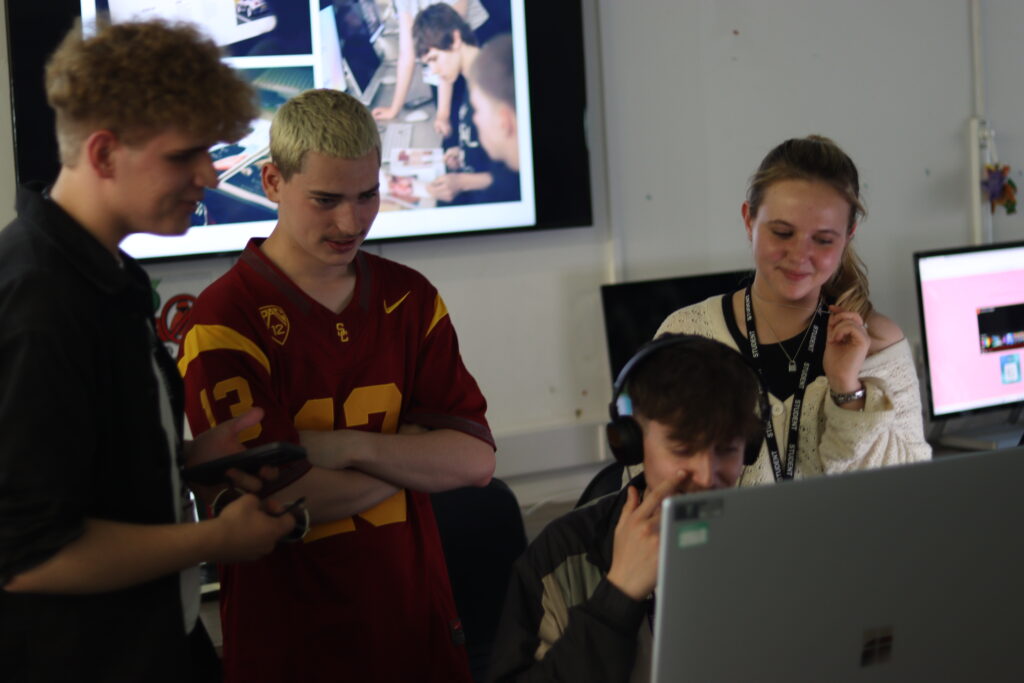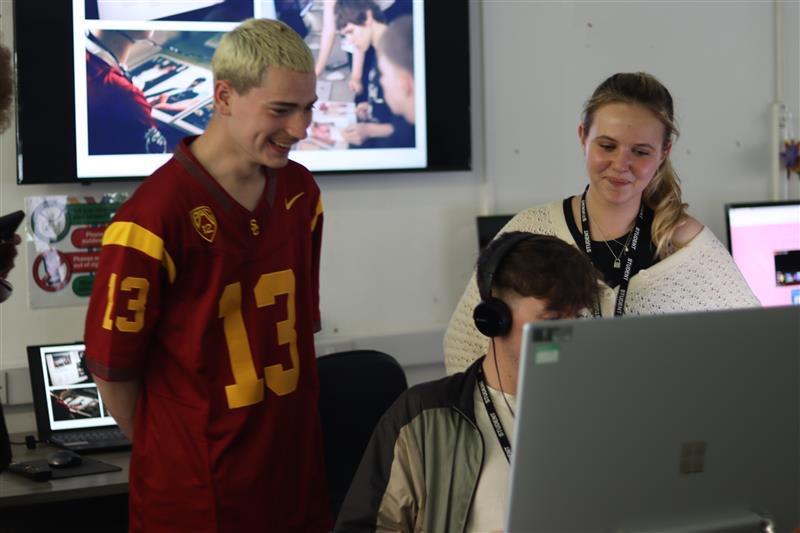For my exhibition, I presented my ideas and development in a slideshow while an audio clip was playing.
Play this audio whilst going through my slideshow:
Here is the feedback from my Exhibition:
Here is my analysis on the exhibition feedback for “The Secret Life of Tortoises.” These results have given me a clearer picture of what’s working well and where I had room for improvement. This involved genuinely understanding how my audience connected with the project and using those insights to make improvement moving forward.
Looking at Audience Demographics, it’s clear we managed to capture a wide range of attention, with most of our feedback coming from people aged 18-25, which was great for collecting diverse perspectives. However, it also highlighted a key point: my primary goal was to connect with 6-12 year olds, and we only had a few direct responses from that age group. This shows that whilst many eyes saw the project (predominantly students), I could have improved my exhibition by getting feedback directly from the kids. In future, it would have been better to actively seek out those younger voices, maybe through sending the project to schools, clubs, or family events, to make sure the project truly meets the correct demographic.
For the engagement with the Project, the short documentary definitely stole the show, pulling in 13 viewers. The tortoise game followed with 7, and the website came in third with 6. This is a clear sign that the visual story-telling in the documentary and the interactive fun of the game were super compelling in comparison to written information. The website, while part of the package, seemed to get a lot less attention. Potentially, I could have used to some stronger visual hooks to boost overall interaction within the website.
Despite the older audience giving us most of the feedback, they were almost spot-on about who the project was for. Almost every single one of the 13 responses confirmed it was perfect for young kids, using phrases like “Primary School Children” or “5-8 yr olds.” This was a massive success show thing that the overall aesthetic, tone, design, and content successfully showed the target audience was children. It’s a clear sign that my project is on the right track, but again, getting a direct children-perspective would be the final piece confirming I am meeting their expectations.
Diving into the engaging elements of the Project, it was clear the documentary and game were the stars. People loved specific moments within the documentary, like “the (tortoise) falling over” or simply “watching the tortoise eat and climb.” It appears the real-life tortoise footage was incredibly engaging. Beyond the fun elements, people also praised the educational value, saying things like “it was very educational about what tortoises do” and that it “taught me the most about their lives in a fun and educational way.” This tells me that I successfully hit that sweet spot between entertainment and learning. Especially, when a parent says “my son loved it and asked to watch it again,” I know I have perfectly managed to reach my target audience.
Based off of my feedback it is evident I nailed the visual engagement, as every single respondent confirmed the visuals kept their attention. For a project aimed at children, this is incredibly important – as chicken have short attention spans visuals are often the gateway to learning and staying engaged. I found this rewarding as I definitely succeeded in creating stimulating content when it came to the visual design choices.
The big question of did they learn anything? The answer was absolutely! For my question on educational Impact, 12 out of 13 people said they “learned a lot,” and one person “learned a few new things.” Nobody felt it really lacked educational value, which is the perfect outcome for an interactive learning resource. It truly shows that my concept of combing of entertainment, fun facts, and engaging storytelling made the content stick and was truly impactful.
In terms of knowledge retention, it was fascinating to see what facts viewers remembered. Everything from tortoises living up to 75 years to them being surprisingly good climbers, and even that their shells are part of their spine, came up. People also recalled more obscure facts like tortoises not having teeth or recognising their owners. This wide range of remembered details, covering both biology and behaviour, highlights how effectively I delivered comprehensive knowledge in a memorable way.
When it came to the clear understanding of jnformation, it was a clean sweep: all 13 respondents found the information “very easy” to understand. This is a huge success, especially for a project aimed at younger audiences where clarity is essential. This tells me that my content was presented in a really clear, accessible way. Similarly, when asking how easy the project was to use and navigate, it was evident that it was a breeze for almost everyone (12 out of 13 found it “very easy,” one “quite easy”). No one reported any trouble getting around, which is fantastic for an interactive resource – it means our layout and how everything flows together felt both natural and intuitive.
As for the game controls and interactivity, the feedback was overwhelmingly positive. Most people (11) found everything “clear,” and the other two said “mostly clear.” This means the game was designed to be easy to pick up and play, which is exactly what I wanted for this age group. It confirms that the interactive part of the project was both enjoyable and simple to use.
Whilst the feedback was mostly glowing in terms of accessibility and comprehension, we did get a couple of small but useful points. An anomaly within my feedback was a person noticing an absence of audio in the documentary at one point, which was a little confusing. When double checking this, by rewatching it my self and checking with peers, it seems this may have been a technical error with the audio source. Another person had some momentary confusion when figuring out how to make the tortoise sleep in the game, though they solved it quickly. To improve this I have added an instruction manual to the menu (three links in the top right) and when hovering over the buttons a short description pops up, as this can make things smoother for everyone.
Overall, the experience rating was phenomenal. I achieve hitting an average of 4.92 out of 5! A total of 12 out of 13 people gave us the highest rating of 5 – “Excellent,” with only one person choosing a rating of 4- “Good.” This almost perfect score really shows how well the project delivered on its promises for engagement, education, and user-friendliness.
When I asked about their favourite elements, the answers were wonderfully varied, but the game and the documentary consistently came up. People loved how “fun” the game was and how “informative” the documentary was, noting it “reaches its audience perfectly.” People also enjoyed the visuals, graphics, and the important clips of the tortoises themselves. This variety tells me I built a well-rounded and really thoughtful learning experience with different things to love for different people.
Finally, for Suggestions for Improvement, it as relieving to hear that over half of our participants felt nothing needed changing, calling it “spectacular” or “great.” However, the few suggestions I did get were incredibly insightful. The previous anomaly about the missing audio in the documentary and the voiceover/subtitle timing are definitely things I can look into to polish the experience. Whilst, the desire for “more content or information” is a great sign that I sparked the intended curiosity. And while one person felt the voiceover tone was slightly “patronising” (though they noted kids might not feel that way), it’s a useful point to consider for future narration. Adding more humor and interactivity to the game also came up. These aren’t criticisms; they’re genuinely constructive ideas that with more time I could have implemented and helped take the project to the next level.
However, the ultimate stamp of approval, was every single one of the thirteen participants said they would recommend this project. That unanimous approval is a
clear testament to the project’s effectiveness, enjoyability, and educational impact. It truly speaks to the positive experience it offers.
Overall, “The Secret Life of Tortoises” is a massive success as an interactive learning resource. It excels in how it engages visually, educates effectively, and leaves people feeling genuinely satisfied. With more time the my next step would have been to actively seek out and listen to the young voices (6-12 year old target audience) to ensure their experience is as fantastic as the adults described. Although there were a few thoughtful tweaks based on this excellent feedback I could have implemented, I am confident to say that “The Secret Life of Tortoises” was a success.
Here are some images from my Exhibition:




